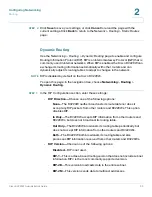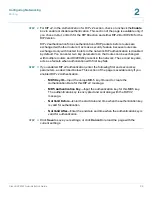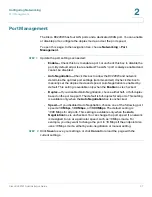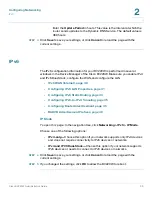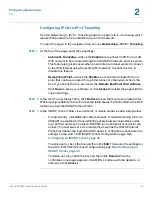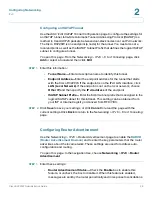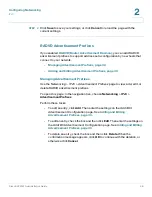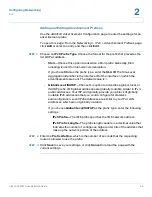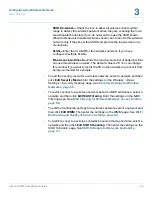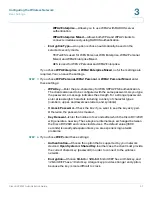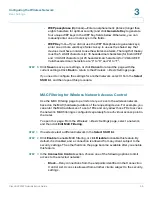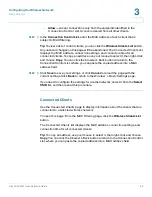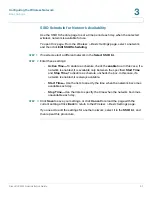
Configuring Networking
IPv6
Cisco RV220W Administration Guide
46
2
Configuring an ISATAP Tunnel
Use the
Add / Edit ISATAP Tunnel Configuration
page to configure the settings for
an ISATAP tunnel. Intra-Site Automatic Tunnel Addressing Protocol (ISATAP) is a
method to transmit IPv6 packets between dual-stack nodes over an IPv4 network.
The Cisco RV220W is one endpoint (a node) for the tunnel. You must also set a
local endpoint, as well as the ISATAP Subnet Prefix that defines the logical ISATAP
subnet to configure a tunnel.
To open this page:
From the
Networking > IPv6 > 6 to 4 Tunneling
page, click
Add
or select a tunnel and then click
Edit
.
STEP 1
Enter this information:
•
Tunnel Name—
Enter a descriptive name to identify this tunnel.
•
Endpoint Address—
Enter the endpoint address for the tunnel that starts
with the Cisco RV220W. If the endpoint is on the IPv4 LAN interface, click
LAN (Local Network)
. If the endpoint is not on the local network, choose
Other IP
, and then specify the
IPv4 address
of the endpoint.
•
ISATAP Subnet Prefix—
Enter the 64-bit subnet prefix that is assigned to the
logical ISATAP subnet for this intranet. This setting can be obtained from
your ISP or Internet registry, or derived from RFC 4193.
STEP 2
Click
Save
to save your settings, or click
Cancel
to reload the page with the
current settings. Click
Back
to return to the
Networking > IPv6 > 6 to 4 Tunneling
page.
Configuring Router Advertisement
Use the
Networking > IPv6 > Router Advertisement
page to enable the
RADVD
(Router Advertisement Daemon)
and to enter the key parameters that the router
advertises about the local network. These settings are used for address auto-
configuration and routing.
To open this page:
In the navigation tree, choose
Networking
>
IPv6
>
Router
Advertisement
.
STEP 1
Enter these settings:
•
Router Advertisement Status—
Check the
Enable
box to enable this
feature, or uncheck the box to disable it. When this feature is enabled,
messages are sent by the router periodically and in response to solicitations.




